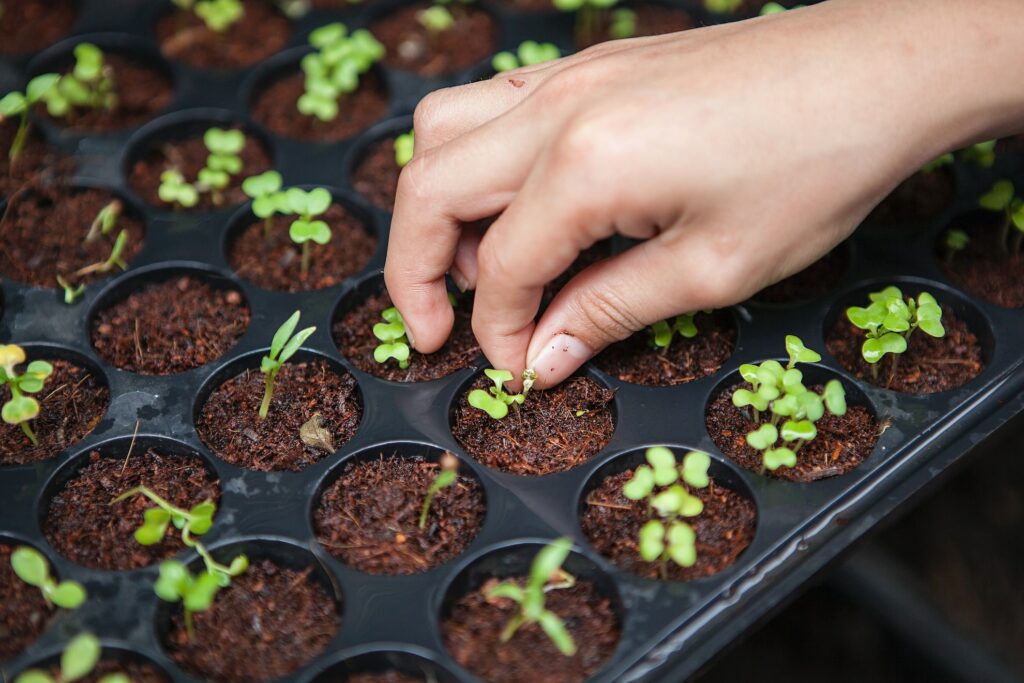Carbon Farming for Climate Resilience

Did you know that San Diego is fortunate to have more small farms than any other county in the nation? With the unique combination of urban and rural landscapes, San Diego was one of the first southern California regions to adopt the framework for carbon farming pioneered by the Marin Carbon Project.
Carbon farming describes a variety of agricultural methods aimed at sequestering atmospheric carbon into the soil and crop roots to mitigate climate change inputs. These practices prevent erosion, increase soil fertility to aid plant growth, and improve the soil’s ability to absorb and hold water. Practices include composting, riparian restoration and other perennial plantings, cover cropping, reduced tillage, and several others.
We talked to Hannah Gbeh, Executive Director at The San Diego County Farm Bureau who facilitates the San Diego Carbon Farming Task Force (SDCFTF). SDCFTF is a coalition comprised of over 50 individuals and organizations representing various sectors across the region, including farmers, researchers, nonprofits, public agencies, institutions, foundations, and private businesses. “Collectively, our group is exploring unconventional partnerships that will both increase and encourage agriculture while working to solve the climate crisis. An example of our work includes the following two reports, produced by San Diego County Farm Bureau, the San Diego Food System Alliance, and Batra Ecological Strategies. These reports are intended for policy makers, farmers, ranchers and all San Diegans interested in learning about climate-friendly farming practices.”
A leading part of the strategy is the application of composted organic waste on crop and range lands and riparian restoration. Compost application on cropland and rangeland has high GHG removal potential (1.5 – 4 MTCO2e /acre/year), and has resulted in remarkable increases in plant growth and water holding capacity improvements. Similarly, restoration of riparian zones between land and a river or stream has GHG reduction potential of 1 MTCO2e/acre/year, and several important co-benefits including water quality improvements and habitat conservation. SDFSA produced a detailed local analysis estimating potential GHG benefits of compost application could sequester over 234,000 MT CO2E annually. A 2018 estimate of agricultural contribution from livestock, fertilizer, and agricultural machinery emissions shows a contrast of163,696 MT CO2e, demonstrating the impact of soil carbon sequestration. Additionally, new and developing California state regulations mandating the diversion of all organic waste from the commercial sector and easier community compost access for residents will continue to make compost more affordable and accessible for area farms while preventing the creation of warming GHG in local landfills.
Solana Center is excited to play a part in the overarching carbon farming strategy by offering education to local farmers, ranch owners livestock owners, and agriculture businesses. This March will kick off a four-part composting series in partnership with the San Diego County Farm Bureau and County of San Diego. This free virtual workshop series will build upon each other as we virtually visit several local sites and address differing concerns and varied strategies, all pertaining to organic waste management. We’ll show how composting can help improve the quality of your soil, protect and conserve water, and improve livestock conditions. We’ll also help demystify permitting requirements. Click the title below to get more information.
3/10 Mid-scale Windrow Composting
3/17 “Shoo, Fly, Shoo!” Pest Control
3/24 Small-scale Aerated Static Pile Composting
3/31 Landscaping for Watershed Protection
Additionally, by facilitating the success of the upcoming younger generation of farmers through training and financing of carbon farming practices, the County can shift the region toward climate-friendly farming practices and regenerative agriculture over the longer-term. Starting March 1 through April 22, 2021, Restore California will be offering a grant for those interested in implementing practices that build healthy soil.
As San Diego County continues making strides for a climate resistant future, it is important to recognize farmers and ranchers who provide ecosystem services to our county. The region’s agricultural strengths provide a strong foundation for carbon farming and partnerships offer hope for building a climate positive and more resilient region.
Sources & Further Resources:
Building a Climate-friendly San Diego from the Ground Up
Linking Climate-friendly Farming Practices to San Diego County’s Climate Action Plan: An Opportunity Analysis of Carbon Farming in the Unincorporated County
San Diego: The Most Robust Carbon Farming Network in Southern California
